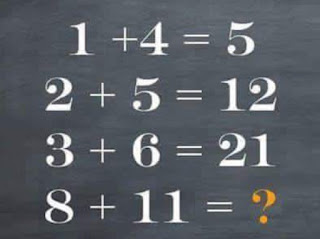 Every now and then something turns up on Facebook that has been shared by 100 bazillion people, with a heading like '99% of people will get this wrong.' Some of these posts are just tedious (like the ones that depend on the order in which you apply mathematical operations), but the one illustrated here apparently has some merit - it looks like a straightforward reverse logic problem. But in reality it seems specifically designed to cause confusion.
Every now and then something turns up on Facebook that has been shared by 100 bazillion people, with a heading like '99% of people will get this wrong.' Some of these posts are just tedious (like the ones that depend on the order in which you apply mathematical operations), but the one illustrated here apparently has some merit - it looks like a straightforward reverse logic problem. But in reality it seems specifically designed to cause confusion.
The problem here is that the sequence does not have a single solution. At the very least you can make an argument for 40 or 96, and stretching things a little, 32 gets a look in.
For me, 96 was the most obvious solution - the process to get the right hand value is multiply the two items on the left and add the first of the original numbers. As for 32, it comes from totally ignoring the items on the left and making the sequence of solutions progress regularly - in this case, the first two are separated by 7, the second two by 9, so it seems reasonable to separate the third pair by 11. And, yes, 40 also makes sense, by adding the solution of the previous line to the left hand side of the next line. (I don't know how someone made it 35.)

Brian
ReplyDeleteThink ye not in decimal. But let me know if you want another correct answer.
Ian
Feel free, though the point really wasn’t about what the solutions are, more the urge for there to be one correct solution.
DeleteIf you treat the left hand side of the puzzle in decimal, the answers in decimal have been restated in Base6, Base5, Base4 and Base3. The answer is 201 in Base3.
ReplyDelete